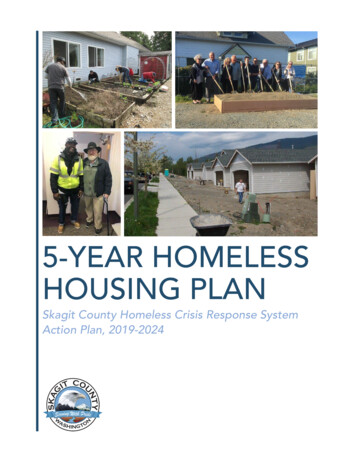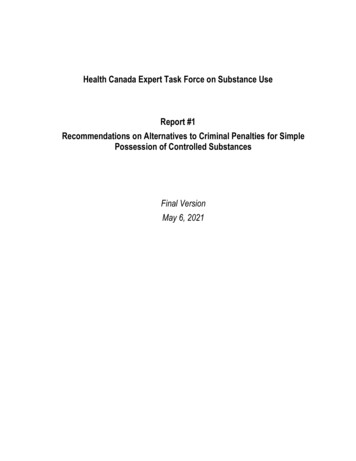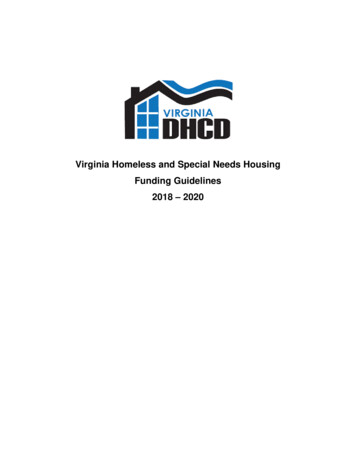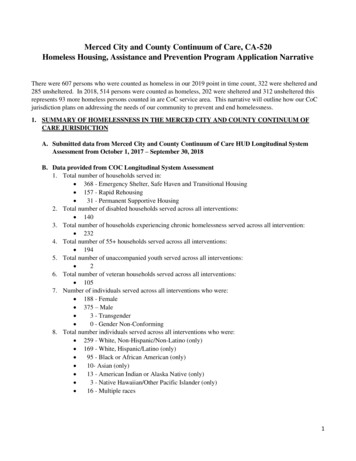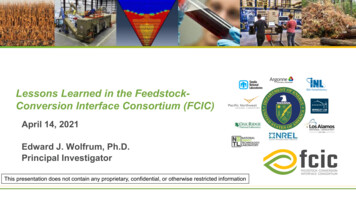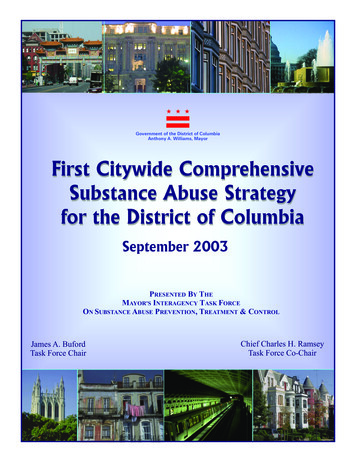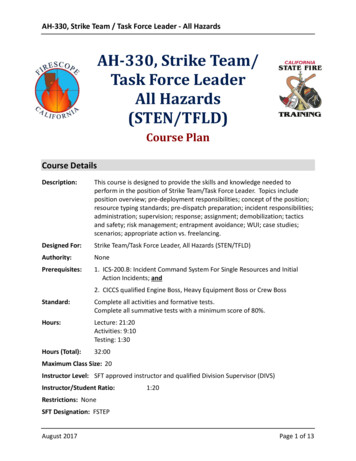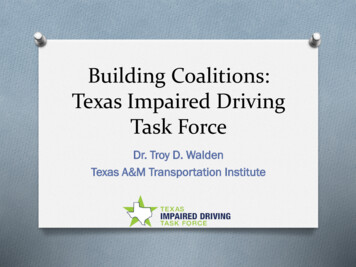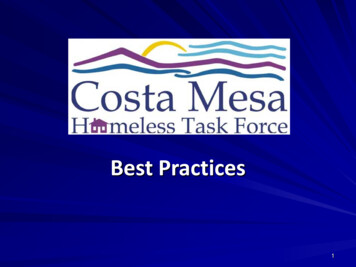
Transcription
Best Practices1
Costa Mesa Homeless Task ForceThe Homeless Task Force was formed by the City Council inJanuary 2011 in response to a series of incidents in the LionsPark vicinityResponse to problems @ Lions Park––––Vagrancy (sleeping in the park)Storage of items in public areas, abandoned property citywideComplaints from library & community center patronsBusiness ownersHomeless sleeping on their property at nightLoiteringMany of the people encountered were mentally ill and/orsuffering from substance abuse2
Costa Mesa Homeless Task ForceMission Statement“Establish Realistic Strategies and MakeRecommendations that Address the Needs ofthe Costa Mesa Community, Residents,Businesses and the Homeless”3
Focus of HTF MeetingsCivility law (ordinance) reviewLaw enforcement, municipal code prosecution & mentalhealth outreachHomeless mental health & medical issuesFinancing strategies/funds available for supportive housingDefinition of a “Costa Mesa Homeless Resident”Vanguard University Homeless Needs Assessment4
Goal/Action Item RecommendationsNine Goals/Action Items:1. Define who is a Costa Mesa Homeless Individual2. Protect the health & safety of CM residents via enforcement of“civility” laws & provide of alternate storage facilities3. Institute proactive resolution for high crime/vice motels that cater totransients & enforce local codes & ordinances at problemhalfway/sober-living homes4. Centralize homeless service coordination5. Coordinated law enforcement, mental health & legal strategy toapproach homelessness6. Explore financing strategies for permanent supportive housing &possible access center7. Interim housing options8. Develop metrics system to monitor reduction in homelessness9. Promotion of Lions Park as a local venue for special events5
Main Findings of HTF Mental illness and substance abuse play major role in homelessnessas does difficulty navigation services No “team work” between governmental entities, mental healthorganizations and faith and non profit communities– Chronic offenders receive multiple citations yet continually return to the City– No coordination with other governmental agencies or non profits– Several motels harbor repeat offenders– Faith organizations assist chronic offenders without establishing clear expectations forservice recipients There is opportunity to improve relationship with faith community in order topartner with them on creating solutions6
Goal 1Define Who is a Costa Mesa Homeless IndividualA Costa Mesa resident is defined as:A person has lived in Costa Mesa for the preceding 36 months at the time they areassessed for residency by city staff or affiliated volunteer organizations, or has beena member of Costa Mesa’s workforce for the same duration. Any exceptions to thisdefinition that surface as result of extraordinary circumstances shall be considered ona case by case basis by the Chair of the Network for Homeless Solutions inconsultation with Network members.There are two (2) ways to provide proof of Costa Mesa Residency:1. Examples of acceptable documentation to confirm recent residency includes:Copy of a previous leaseConfirmation of previous utility serviceConfirmation of residency from a previous landlord, or proof of residency intransitional living facilitySchool records7
Goal 1Define Who is a Costa Mesa Homeless Individual2.Proof of strong ties to the community: Proof that the individual and/or their dependent(s) attended K-12school in Costa Mesa within the past 10 years and have been reestablished in the community for at least one year. Knowledge—either first hand or recorded—by the Costa MesaPolice, Fire Department, City Community Outreach Workersand Trellis Volunteers and/or the Costa Mesa Code EnforcementDepartment that the individual has been living on Costa Mesa’sstreets for the prior 36 months.8
Goal 1Define Who is a Costa Mesa Homeless IndividualEXCEPTIONSVulnerable homeless individuals, including those identified by the VI-SPDAT whosewell-being will be severely compromised by living on the street. Efforts to assist theseindividuals will be limited to stabilization and placement in housing or return to theircommunity of origin.Homeless individuals identified by City Staff (i.e. CMPD, Fire and CommunityOutreach Workers) as high users of City resources and services are not Costa MesaHomeless Residents unless they meet the aforementioned thresholds and conditions.The NHS will determine on a case by case basis the extent of service efforts affordedthese individuals, with the final determination by the Chair of the Network forHomeless Solutions in consultation with Network members. In most cases, NHSefforts will be limited to reconnecting these individuals to their communities of origin.9
GOAL 2Protect the Health & Safety of CM Residents ThroughEnforcement of “Civility” Laws &Provision of Alternate Storage FacilitiesReduce homelessness in CM via coordinated actions to createprocesses & policies that will lead to a reduction inhomelessness & an increase in the City’s quality of lifeEstablish ordinances that create the means by which the Citycan enforce desired outcomes10
OrdinancesParkingCampingStorage Ordinance & Alternative Storage SiteFood SharingProhibition on SmokingBan on Sex Offender in ParkBike Rack11
Goal 2Parking Ordinances (New)Parking issues result as vehicles park for long periods of timein City parks which results in vehicle owner/occupant usingthe space for lodging purposes & possibly preventingresidents from parking in order to recreate in City parksHTF RECOMMENDATION:– No overnight parking in parks except by permit12
Goal 2Camping Ordinance (Existing)Anti-camping/lodging ordinances are not necessarilyunlawful, but Best Practices suggest to avoid allegations ofcivil rights violations an alternate location should be providedso that an individual’s ability to sleep is unabridgedHTF RECOMMENDATION:– Enforce anti-camping ordinances as part of a legal strategy connectedto actions that link homeless to housing– Ensure park is closed at nightUpdate – Enforced with discretion. Code Enforcement now enforcing camping onprivate property13
Goal 2Storage Ordinance & Alternative Storage SiteEnforcement of personal property storage ordinances are bestdefended from litigation when alternate storage sites areprovidedHCD staff & Church Consortium met regarding the utilizationof church property for this purposeHTF RECOMMENDATION:– Update & enforce existing personal property storage ordinances & ifpossible, partner with faith-based/nonprofit organizations to provideaccessible & secure locations for homeless to store & retrieve personalpropertyUpdated – Adopted 201314
Goal 2Food Sharing Ordinances (New)Restricting individuals from feeding the homeless is an actionthat has been subject toEffective enforcement of food sharing ordinances may dependon other “positive” actions by CityHTF RECOMMENDATION:– Research ordinances limiting food sharing programs in City parks &other public locationsUpdate – Legal Counsel states most limitation on food sharing challenged in courtFocus on centralizing food distribution in City and encouraging faith basedorganizations to do the same15
Goal 2Prohibition on Smoking OrdinancesCM Parks & Recreation Commission recommended expandingproposed smoking ban to include:– All City-owned buildings, facilities & motor vehicles– Areas within fenced areas (including parking lots if not within thefenced areas) of City owned sports fields– City owned community gardens– Within 50 ft. of any City park (parking lots included in parkboundaries)HTF RECOMMENDATION:– HTF recommended supporting ordinanceUpdate: Ordinance approved by City Council in Fall 201116
Goal 2Ban Sex Offenders in Park OrdinanceThe City Attorney is researching the feasibility of an ordinanceto exclude registered sex offenders from city parks & youthsports fields owned/operated by the CityPotentially constitutional rights issuesThe City Attorney is preparing a legal analysis for Council toevaluate whether to adopt such a restrictionHTF RECOMMENDATION:– That the City Council adopt an ordinance banning registered sexoffenders from City owned parks & recreation facilitiesUpdate – Adopted, overturned in State and Federal Court17
Goal 2Bike Rack Ordinance (New)New ordinance not previously discussed by Task ForcePurpose of the Ordinance was ensure that bike racks wereused for their intended purpose and to curb the number ofabandoned bikes in the CityTo be discussed with Council to obtain additional directionHTF RECOMMENDATION:– None at this time, although there is general supportUpdate – Bike Rack Ordinance adopted18
Goal 3Institute Proactive Problem Resolution with regard to HighCrime/Vice Motels Catering to Transient Population &Enforcement of Local Codes & Ordinances at ProblemHalfway/Sober-Living HomesOne cause for influx of homeless to CM is a proliferation of motels& sober living homesLaw enforcement agencies from other jurisdictions (Probation &Parole) utilize these motels & sober living homes for clientsHTF RECOMMENDATION:– That staff explore changes to current building codes that could reduceor mitigate impact of half way/sober living homes on residential &business neighborhoodsUpdate: This action incorporated into 2 interdepartmental effortsconsisting of problem motels & sober living enforcement and network forhomeless solutions19
Goal 3Partner with Parole & ProbationA combined State Parole, County Probation & City CodeEnforcement team could inspect motels & recovery homes toensure they operate in accordance with CUPs & thatindividuals residing in units are not violating terms of paroleor probationHTF RECOMMENDATION:– That staff pursue a partnership with Probation & Parole personnel toproactively inspect recovery/halfway homes to ensure codecomplianceUpdate: This action has been incorporated into motel, sober living andnetwork for homeless solutions task forces20
Goal 4Centralized Homeless Services CoordinationHomeless issues impact outside jurisdictions & entitiesBest practices suggests one department be responsible forcoordination of homeless services & complaintsThis department should be responsible for:– Coordinating in-house & outside efforts– Addressing homeless complaints by coordinating responses withCMPD, City Attorney, other City departments & outside agencies– Evaluating new techniques for addressing homeless issues– Homeless Task Force strategies/recommendationsHTF RECOMMENDATION:– Continue centralized homeless services coordination21
Network for HomelessSolutionsNetwork forHomelessSolutionsCity AttorneyRick FrancisKathya icesChief MikeBrumbaughGovernmentAgenciesPrivatePartnersOC mmunityServicesCity OutreachTeamCommunityOutreachWorkerS. BowlerPoliceDepartmentLt.BakkilaIntern (2)Lt. LaPointeOutreachWorker tJon NealBruceHartleyNonProfits- Mercy House- Collette’sChildren’s Home-- SOS- WorkingWardrobes- Broken HeartsMinistries- Fresh Beginnings- Off the Streets- Families ForwardFaithBasedPartners- Trellis- Light House- Church of Christ- The Crossing Church- Rock Harbor- St. Joaquim- St. John the Baptist- Queen of Angels- St. John’sEpiscopal
Goal 5Integrate Law Enforcement, Mental Health &Legal Strategy as a Collaborative Approach toHomelessnessBest practices suggests that the enforcement of codes &policies may require a new approach that includes a“homeless-specific” policy/legal strategyThe City should consider adopting a collaborative approach tolaw enforcement that includes arresting chronic offenders &criminals while working with the City Attorney, CMPD &mental health outreach workers to help move the homelessoff the streets23
Goal 5Create Homeless Enforcement TeamCities that have success with homeless issues usually haveofficers trained in homeless specific solutionsAs the 1st responders to homeless calls for service a homelessofficer can free up officers to return to patrol dutyHomeless outreach officers build rapport with homelesswhich helps assess long-term needs of the chronic homelessHTF RECOMMENDATION:That the City explore the deployment of a “Homeless OutreachOfficer” Update: On hold due to resource constraints. Program to beimplemented in 201624
Goal 5Coordinate Mental Health/Street OutreachPresently service providers visit CM libraries & parks weekly– E.g., OC Mental Health, Veterans 1st, VACMPD calls these agencies for assistance as neededService providers often need multiple encounters to buildtrust & assess needs of homeless to remove from streetsThe City may be able to expedite trust-building process andaccess to services by funding a PT street outreachteam/workerHTF RECOMMENDATION:– Recommend that staff explore contract opportunities with qualifiedproviders to coordinate mental health & street outreach services forCosta Mesa homeless residentsUpdate: Community Outreach Team established with CountyCollaboration25
Goal 5Formalize Legal Assistance to ProsecuteChronic ViolatorsDevelop a multi-faceted legal strategy that involves a strongerpresence in court when transients appear before a judgeCity Attorney’s Office will prosecute municipal code violationsfor repeat offenders & will communicate with DA’s officeregarding specific cases of interestThis approach could result in the ability to remove peoplefrom the community who commit repeated offenses & whorefuse assistanceHTF RECOMMENDATION:– Formalize support for this current legal strategyUpdate – In process26
Goal 5Provide Emergency Motel Vouchers for CMPDCMPD occasionally encounter situations that require rapid,temporary placement of vulnerable individuals/families intosafe/decent housingCMPD should have a supply of vouchers for emergencysituations especially for families with children found sleepingin the streetHTF RECOMMENDATION:– That staff identify resources to provide CMPD with motel vouchers foremergency situations & help develop criteria for the use of vouchersUpdate – Implemented and includes transportation vouchers27
Goal 6Research Permanent Supportive Housing &Possible Access Center for CM Homeless ResidentsBest practices suggest the availability of supportive housing & adaytime facility where homeless may congregate helps reduceimpact of the homeless on neighborhoods & local businessesFacility location must ensure impacts to surrounding neighborhoodsare mitigatedThese facilities would only be accessed by CM homeless based onthe definition conceived by the HTFHTF RECOMMENDATION:– Have staff explore the possibility of financing strategies for thedevelopment of supportive housing/accessUpdate: Project on hold based on neighborhood opposition to proposed site28
Goal 8Develop a Metrics System to MonitorReduction in HomelessnessBest practices suggests a homeless strategy should measureimpact of actions on the homelessCM should develop appropriate metrics system to measuresuccess or failures of its homeless strategy including areduction in homelessnessRECOMMENDATION:– Develop analytical tool to measure homeless reduction resulting fromimplementation of the City’s homeless strategyUpdate – City has implemented information management system which tracks allclients assisted including services received, case management hours and notes29
Goal 5 - Community OutreachWorkersThe City employs 2 part-time communityoutreach workers Monday-Saturday.Primary responsibilities:– Forming relationships with homelessindividuals on the vulnerability list– Helping them find them services.Concentration on individuals on the list or thoseindividuals who are defined as “Costa MesaHomeless Residents” by City staff and CMPD.To avoid becoming an attractant for individualsoutside of Costa Mesa, the outreach workerswork primarily with individuals who meet thisdefinition.
Community Outreach WorkersOutreach workers collaborate withsocial service providers to attempt toget homeless individuals:–––––services or housingobtaining I.D., birth certificates, etc.reunite them with family memberstransportation to take them to homeless court & medical apptscontinually follow up on their progress.If a client requires hospitalization, themental health worker coordinates theircare with hospital social workers so thatclient is not released directly to thestreets
How Can Outreach Workers HelpPublic Safety/Policy Makers?Collaborate on cases involvinghomeless people who have to means tomove off the street or chronic offendersresistant to changeOutreach workers can locate substanceabuse program, housing, familymembers for reunification and othersocial service programsDe-escalation of aggressionQuickly approach new arrivals to the cityand convince them to return to theirlocation of origin
BEFORE HOMELESS TASKFORCE OUTREACH/COORDAFTER HOMELESS TASKFORCE OUTREACH/COORD 245,000 in City ResourcesCitizen complaints140 homeless on streetsCOSTSCitizen complaint processCOSTSNo coordination amongst faithbased groups & homelessproviders105 housed over past 3years 40,000 in homeless grantsgiven out haphazardlyEstimate 20,000 in policetransient calls not includingtime spent in hospitals doingmedical clearanceBENEFITSNoneOngoing political supportEducation and re-educationof residents, businesses andpolitical officials637 linked to servicesBENEFITS 60,000 in grants to targetedCM homeless residents52 Chronic homelessresidents assessed forCoordinated Entry Program33
What Can we Learn from Costa Mesa?1.Must balance needs of residents, businesses, homeless2.Services targeted to Costa Mesa Homeless Residents includedthose offered by city funded non profits3Centralized homeless coordination and partnership of streetoutreach, public safety, faith and non profit organizationscritical to a city’s successData driven metrics must be includedTransportation to services and targeted street outreach is key to successfuloutcomes34
What Can we Learn from Costa Mesa?4.In house working groups create better coordination of City andmulti-jurisdiction resources for reducing impact of factorscontributing to chronic homeless, reduction in criminal activityand quality of life5.You can start small and be effective – Costa Mesa has placed105 people in housing and linked hundreds of other to servicessince 2012 with small part time staff6.Housing is key to ending homelessness – However it can betailored to local residents and include both public and privateresources35
QUESTIONS?36
halfway/sober-living homes 4. Centralize homeless service coordination 5. Coordinated law enforcement, mental health & legal strategy to approach homelessness 6. Explore financing strategies for permanent supportive housing & possible access center 7. Interim housing options 8. Develop metrics system to monitor reduction in homelessness 9.

